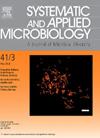Assessment of cluster analysis of elastic light scatter profiles for the identification of foodborne Bacteria
IF 4.2
2区 生物学
Q2 BIOTECHNOLOGY & APPLIED MICROBIOLOGY
引用次数: 0
Abstract
Elastic Light Scatter (ELS) profiling is a novel approach for simultaneous detection and identification of bacteria cultured on solid agar media. The profiles comprise a range of different scatter features that can be used jointly or individually as a basis for comparison. We examined the utility of cluster analysis of ELS profiles for classification and identification of bacteria of relevance to foods. A total of 1562 colonies from 48 strains, representing 17 different species distributed among four genera, were examined. Each of three scatter-derived features (Zernike moments, pseudo-Zernike moments, proprietary Patsekin elements) were used individually and in combination for the cluster analysis. Of these, a combination of Patsekin elements and pseudo-Zernike moments yielded clusters that best reflected the known taxonomic relationships among the strains examined. Evidence of Genus-level markers of colony architecture was seen and there was a general agreement of clustering at the species level. Nonetheless, some individual colonies did not cluster with the majority of others from the same taxon, which could reflect an aberrant ELS phenotype, or known challenges in depicting strain relationships using cluster analytical methods. However, when compared with UMAP data processing, relationships between individual colonies were more easily discerned by inspecting the dendrogram. Cluster analysis of ELS profiles is a useful adjunctive tool for the classification and identification of bacteria and results may also be helpful in informing the development and improvement of other data analytical tools for ELS profile analysis.
弹性光散射聚类分析在食源性细菌鉴定中的应用评价
弹性光散射(ELS)分析是一种同时检测和鉴定在固体琼脂培养基上培养的细菌的新方法。所述轮廓包括一系列不同的散点特征,可联合或单独用作比较的基础。我们检查了聚类分析的ELS概况分类和鉴定相关的食品细菌的效用。共检测了4属17种48株的1562个菌落。三个散点衍生特征(Zernike矩、伪Zernike矩、专有Patsekin元素)中的每一个都被单独或组合用于聚类分析。其中,Patsekin元素和伪zernike矩的组合产生了最能反映所检查菌株之间已知分类关系的簇。发现了属水平的群体结构标记的证据,并且在种水平上有普遍一致的聚类。尽管如此,一些单独的菌落没有与来自同一分类单元的大多数其他菌落聚集在一起,这可能反映了异常的ELS表型,或者在使用聚类分析方法描述菌株关系方面存在已知的挑战。然而,与UMAP数据处理相比,通过检查树突图更容易识别单个菌落之间的关系。聚类分析是一种有益的细菌分类和鉴定辅助工具,其结果也可为其他用于细菌分类和鉴定的数据分析工具的开发和改进提供参考。
本文章由计算机程序翻译,如有差异,请以英文原文为准。
求助全文
约1分钟内获得全文
求助全文
来源期刊

Systematic and applied microbiology
生物-生物工程与应用微生物
CiteScore
7.50
自引率
5.90%
发文量
57
审稿时长
22 days
期刊介绍:
Systematic and Applied Microbiology deals with various aspects of microbial diversity and systematics of prokaryotes. It focuses on Bacteria and Archaea; eukaryotic microorganisms will only be considered in rare cases. The journal perceives a broad understanding of microbial diversity and encourages the submission of manuscripts from the following branches of microbiology:
 求助内容:
求助内容: 应助结果提醒方式:
应助结果提醒方式:


